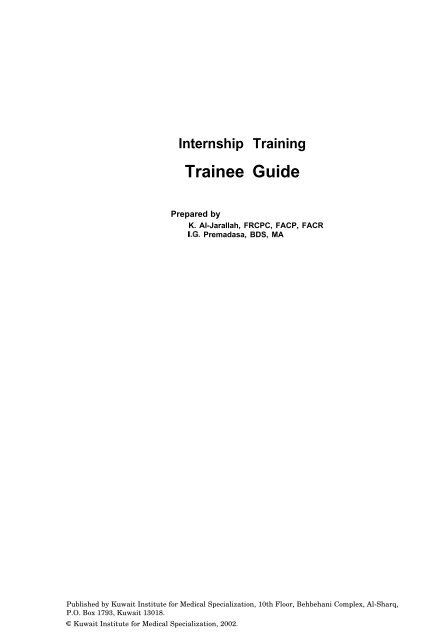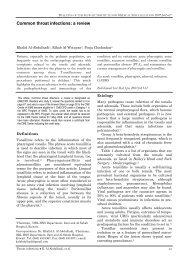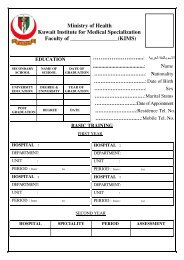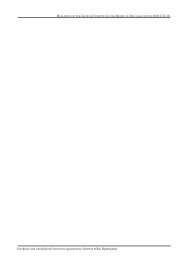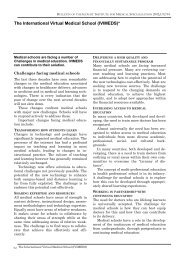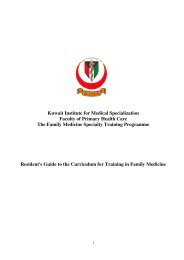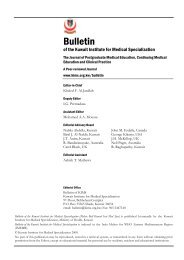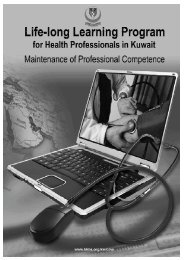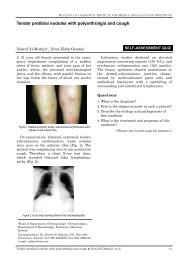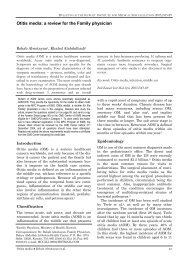Trainee Guide - Kuwait Institute for Medical Specialization
Trainee Guide - Kuwait Institute for Medical Specialization
Trainee Guide - Kuwait Institute for Medical Specialization
Create successful ePaper yourself
Turn your PDF publications into a flip-book with our unique Google optimized e-Paper software.
Internship Training<br />
<strong>Trainee</strong> <strong>Guide</strong><br />
Prepared by<br />
K. Al-Jarallah, FRCPC, FACP, FACR<br />
LG. Premadasa, BDS, MA<br />
Published by <strong>Kuwait</strong> <strong>Institute</strong> <strong>for</strong> <strong>Medical</strong> <strong>Specialization</strong>, 10th Floor, Behbehani Complex, Al-Sharq,<br />
P.O. Box 1793, <strong>Kuwait</strong> 13018.<br />
0 <strong>Kuwait</strong> <strong>Institute</strong> <strong>for</strong> <strong>Medical</strong> <strong>Specialization</strong>, 2002.
Name of trainee.................................................................<br />
Date of issue-...................................................................<br />
Signature..........................................................................<br />
Contents<br />
Preface<br />
<strong>Trainee</strong> <strong>Guide</strong> and its role<br />
Purpose of guide<br />
Constituent elements<br />
Outcomes objectives of internship training<br />
General objectives<br />
Specialty objectives in Medicine<br />
Specialty objectives in Surgery<br />
Specialty objectives in Obstetrics & Gynecology<br />
Specialty objectives in Pediatrics<br />
Specialty objectives in Primary Care<br />
Record of <strong>for</strong>mative and summative evaluations<br />
Medicine, Surgery, Obstetrics & Gynecology, Pediatrics, Primary Care<br />
Interaction cards<br />
<strong>Trainee</strong> notes<br />
1<br />
6<br />
7<br />
9<br />
12<br />
17<br />
20<br />
24<br />
26<br />
31
internship year<br />
Preface<br />
On obtaining the MBChB or MBBS qualification from the medical school, the<br />
newly graduated doctors become eligible to receive a temporary license <strong>for</strong> the<br />
practice of medicine. During a one-year period from then on, termed the internship<br />
year, they engage in practice under close supervision. The intern (also called<br />
the pre-registration house officer, in some countries) enters rotations in medicine,<br />
surgery, obstetrics & gynecology and pediatrics, and under some programs, in primary<br />
care.<br />
In <strong>Kuwait</strong>, the <strong>Kuwait</strong> <strong>Institute</strong> <strong>for</strong> <strong>Medical</strong> <strong>Specialization</strong> has been entrusted<br />
with the overall responsibility <strong>for</strong> administering internship training. This guide<br />
has been prepared with the aim of indicating the minimum competencies expected<br />
of the trainee be<strong>for</strong>e completing the internship. The trainees are encouraged to go<br />
beyond this target level, whenever opportunities permit.<br />
I. Purpose of <strong>Guide</strong><br />
<strong>Trainee</strong> <strong>Guide</strong> and its Role<br />
This <strong>Trainee</strong> <strong>Guide</strong> indicates the competencies that interns are expected to acquire<br />
be<strong>for</strong>e completing the rotations during the internship year. Additionally, it<br />
provides a mechanism <strong>for</strong> recording a sample of the abilities that the intern<br />
gained, and the level at which they were completed. It also has a checklist <strong>for</strong> the<br />
procedures that the intern is expected to per<strong>for</strong>m in each rotation.<br />
II. Constituent Elements<br />
1. Learning Objectives<br />
A set of learning objectives has been listed <strong>for</strong> each rotation. They specify the<br />
abilities that the trainee is expected to possess by the time the attachment is<br />
completed. They are written as outcome objectives from the viewpoint of the<br />
learner, rather than what the teacher intends to do. Additionally, these expected<br />
competencies would fall into three broad categories: (i) knowledge, (ii)<br />
procedural skills, and (iii) attitudes and values. The guide, there<strong>for</strong>e, would<br />
benefit the trainee as well as the supervisor in planning and organizing the<br />
learning activities and assessing the per<strong>for</strong>mance.
2. Interaction Cards<br />
Each <strong>Guide</strong> has 30 interaction cards. These cards enable the trainee to arrange<br />
<strong>for</strong> evaluation of his per<strong>for</strong>mance by the supervisor.<br />
Page 1 of the card gives a <strong>for</strong>mat <strong>for</strong> evaluation of the trainee’s per<strong>for</strong>mance by<br />
the supervisor. Six categories of clinical per<strong>for</strong>mances are listed, with room <strong>for</strong><br />
an additional one. On any occasion, the evaluator would focus on one of the<br />
seven areas mentioned. A 5-point scale is given <strong>for</strong> rating the per<strong>for</strong>mance.<br />
Page 2 of the card has space <strong>for</strong> the trainee to write the relevant patient notes.<br />
How to Use<br />
The <strong>Trainee</strong> Division of KIMS would issue a copy of the <strong>Trainee</strong> <strong>Guide</strong> to every<br />
trainee at the time of registration in the internship training program. The<br />
trainee is expected to obtain evaluations of a minimum of 20 of his or her clinical<br />
encounters during each rotation. All evaluations need to be in relation to<br />
patients, and should reflect a variety of clinical conditions.<br />
When the trainee is ready <strong>for</strong> an evaluation, he in<strong>for</strong>ms the supervisor or<br />
trainer of his wish so that an evaluation could be scheduled. The trainee then<br />
2<br />
writes the essential data regarding the patient on page 2 of a card, and presents<br />
the card, without detaching it from the <strong>Guide</strong>, to the supervisor or<br />
trainer. The trainer fills in the relevant cages in Section I on page 1, and<br />
checks (J) in the appropriate spaces in Section II. Comments on traineeper<strong>for</strong>mance<br />
is <strong>for</strong> listing additional comments by the trainer.<br />
On completing the evaluation, the trainer would conduct a review session with<br />
the trainee to show the latter’s strengths and weaknesses. This encounter<br />
would constitute a <strong>for</strong>mative evaluation, giving the trainee an opportunity to<br />
pay additional attention to topic areas that need to be improved. The <strong>Guide</strong><br />
with the completed card is handed back to the trainee. Be<strong>for</strong>e completing the<br />
rotation, the trainee is required to show all the completed cards pertaining to<br />
the rotation to the designated supervisor so that a final meeting could be arranged<br />
at which the overall per<strong>for</strong>mance is discussed. This end-of-rotation<br />
summing up of abilities <strong>for</strong>ms a summative evaluation. On this occasion, the<br />
supervisor averages the ratings of the previous per<strong>for</strong>mances, and records the<br />
data in the appropriate section (pages 26 to 30) in the <strong>Trainee</strong> <strong>Guide</strong>. The<br />
<strong>Trainee</strong> <strong>Guide</strong> with its cards are then <strong>for</strong>warded, under confidential cover, to<br />
the <strong>Trainee</strong> Division of KIMS (Fig 1). The responsibility <strong>for</strong> sending them lies<br />
with the designated supervisor in the specialty at the hospital.<br />
3
3. <strong>Trainee</strong> Notes<br />
Interaction Cards<br />
with final report to<br />
I KIMS I<br />
<strong>Trainee</strong> Division<br />
Fig. 1. Use of Interaction Cards<br />
4<br />
Space is provided at the end of the guide <strong>for</strong> the intern to make his own notes.<br />
These would help him to identify content areas that need special attention. The<br />
trainee would also mention skills that are common to more than one rotation,<br />
but which could not be mastered within the time allocated. Such recording<br />
would help him to use subsequent rotations to improve these skills.
Outcome Objectives of Internship Training<br />
The abilities that the trainees are expected to have gained by the time they complete<br />
internship training are described below as outcome objectives. They are<br />
grouped under two categories:<br />
� General objectives, which are common to more than one specialty, and can<br />
there<strong>for</strong>e be achieved during multiple attachments (Some of these may appear<br />
again under specialty objectives);<br />
� Specialty objectives, which are the expected outcomes in the individual specialties<br />
during the rotations;<br />
In addition, under each specialty a set of procedures that the trainee is expected<br />
to per<strong>for</strong>m satisfactorily is listed.<br />
General Objectives<br />
At the end of internship training, the intern is expected to have a level of knowledge,<br />
skills, and attitudes and behaviors needed to embark on a career as a health<br />
care provider, or to pursue further training in a medical specialty.<br />
On conclusion of internship training, the intern will:<br />
1. Be aware of the implications of the principles of medical ethics, clinical epidemiology,<br />
outcomes of research and the patient’s social and cultural background<br />
on medical decisions;<br />
2. Be able to evaluate the quality of in<strong>for</strong>mation, and to utilize analytical and<br />
data synthesizing skills appropriately;<br />
3. Be able to interact effectively with patients, and all members of the health care<br />
team;<br />
4. Understand the roles and relationships of primary care and specialty care providers;<br />
5. Be able to outline the administrative procedures related to patient admissions,<br />
inpatient care, and discharge plan of patients;
6. Be aware of medico-legal issues in relation to births, mortality, abortion, and<br />
accidental injuries, with specific reference to the regulations of the Ministry of<br />
Health and the procedures in <strong>Kuwait</strong>;<br />
7. Posses a sense of responsibility <strong>for</strong> patient care, and respect patient and family<br />
confidentiality;<br />
8. Be able to make presentations on practical problems in medicine at clinical<br />
meetings, grand rounds, journal clubs and other similar gatherings, using appropriate<br />
media;<br />
9. Be aware of own limitations, and be willing to ask <strong>for</strong> assistance when necessary.<br />
8<br />
Specialty Objectives in Medicine<br />
At the completion of the training program, the intern will:<br />
1. Be able to clerk patients upon admission, which includes taking a relevant<br />
history and conducting an appropriate physical examination;<br />
2. Be able to select and request <strong>for</strong> relevant diagnostic tools, and interpret the<br />
findings of investigations;<br />
3. Be able to undertake problem identification and arrive at a logical differential<br />
diagnosis;<br />
4. Be able to arrive at a working diagnosis and develop a management plan;<br />
5. Be able to educate patients making them aware of their illnesses;<br />
6. Be able to per<strong>for</strong>m specified diagnostic and therapeutic procedures (to be<br />
listed);<br />
7. Be able to manage acute medical patients under supervision, sharing in the<br />
concerned duties and responsibilities;<br />
8. Be able to administer cardio-pulmonary resuscitation when needed;<br />
9
9. Be able to provide emergency management in acute myocardial infarction,<br />
acute respiratory insufficiency, anaphylaxis, intoxication, status epilepticus,<br />
diabetic coma, pulmonary embolism, and septicemia/meningitis;<br />
10. Be able to write relevant discharge summaries, medical reports and death<br />
certificates;<br />
11. Be able to communicate effectively with patients and relatives and win their<br />
confidence;<br />
12. Be motivated to engage in ethically acceptable medical practice;<br />
13. Be motivated to establish productive and harmonious relationships with colleagues<br />
and other health professionals.<br />
Procedural Skills in Medicine<br />
10<br />
Instructions to assessor: The procedures that the intern is expected to be able to<br />
per<strong>for</strong>m satisfactorily in the specialty of Medicine are listed below. Check (J)<br />
against each item after observing directly.<br />
Administering cardio-pulmonary resuscitation 0 Securing airway 0<br />
Artificial ventilation 0 Endotracheal intubation tl<br />
Insertion of central venous catheter cl<br />
Treatment of tension pneumothorax 0<br />
Pericardiocentesis 0<br />
Needle aspiration of the knee joint cl<br />
Arterial puncture <strong>for</strong> blood gas analysis 0<br />
Insertion of thoracic drainage 0<br />
Cardiac defibrillation 0<br />
Laboratory procedures and special investigations that the intern is expected to be<br />
able to per<strong>for</strong>m satisfactorily are listed below. Check (J) against each item after<br />
observing directly.<br />
Blood sampling � Microbiological sampling 0<br />
Examination of blood film � Microscopic examination of microbiological specimens �<br />
Urine examination 0 Basic ECG interpretation 0<br />
Basic X-ray interpretation 0<br />
11
Specialty Objectives in Surgery<br />
On completion of the training program, the intern will:<br />
1. Be able to clerk the surgical patient, through relevant history taking and appropriate<br />
physical examination;<br />
2. Be able to plan appropriate investigation protocols to assist in making a definitive<br />
diagnosis;<br />
3. Be able to interpret the results of common radiographic and laboratory investigations,<br />
relating them to the clinical problem at hand;<br />
4. Be able to describe the pre-operative preparation of patients <strong>for</strong> major surgical<br />
procedures;<br />
5. Be able to assist in the pre- and post-operative management of surgical patients;<br />
6. Be able to provide primary treatment of trauma wounds, and undertake suturing<br />
of wounds and removing sutures;<br />
7. Be able to provide first aid, debridement, excision and dressing of wounds;<br />
12<br />
8. Be able to provide emergency management of trauma, shock, and burns;<br />
9. Be able to provide emergency on call services, with assistance where necessary;<br />
10. Possess desirable bedside manners that would facilitate the clinical interaction<br />
with the patient and their relatives;<br />
11. Be able to use appropriate strategies when breaking bad news to the patient;<br />
12. Be able to write discharge summaries, medical reports, sick leave and death<br />
certificates;<br />
13. Be able to write admission notes, follow up notes, requests <strong>for</strong> investigations<br />
and their results, and notes <strong>for</strong> preoperative and postoperative care including<br />
prescription of relevant drugs;<br />
14. Be aware of investigations carried out in associated departments, e.g. in Radiology,<br />
Pathology, Gastroenterology;<br />
15. Value observing punctuality in discharging clinical and administrative duties;<br />
13
16. Be able to write adequate clinical notes on patients seen on emergency duties<br />
<strong>for</strong> follow-up surgical management.<br />
Procedural Skills in Surgery<br />
14<br />
Instructions to assessor: The procedures that the intern is expected to be able to<br />
per<strong>for</strong>m satisfactorily, under supervision where necessary, in the specialty of Surgery<br />
are listed below. Check (J) against each item after observing directly.<br />
Examination of post-operative wounds 0<br />
Cardio pulmonary resuscitation cl<br />
Collection of specimens <strong>for</strong> lab investigations 0<br />
Anorectoscopy, proctoscopylsigmoidoscopy 0<br />
Scrubbing, gowning and suturing 0<br />
Incision and closure 0<br />
Tissue handling 0<br />
Endotracheal in tu bation cl<br />
Assisting in minor and major operations 0<br />
Indirect laryngoscopy 0<br />
Assisting in appendectomy 0<br />
Per<strong>for</strong>ming appendectomy cl<br />
15<br />
Treatment of ingrown toenail<br />
Irrigation of the ear<br />
Insertion of intravenous line<br />
Insertion of central venous catheter<br />
Insertion of Foley’s catheter<br />
lntubation - drainage in OR<br />
Circumcision<br />
Treatment of epistaxis<br />
Venous cut-down<br />
Removal of <strong>for</strong>eign body<br />
Catheterization - NGT<br />
Endotracheal intubation<br />
0<br />
0<br />
�<br />
�<br />
�<br />
�<br />
�<br />
�<br />
�<br />
��<br />
�<br />
�
Skin biopsies, excision of small lumps<br />
and removal of superficial tumors Cl<br />
16<br />
Incision and drainage of abscesses,<br />
collection of suppurations 0<br />
Specialty Objectives in Obstetrics & Gynecology<br />
On completion of the training program, the intern will:<br />
1. Be able to take a relevant history and per<strong>for</strong>m a basic physical examination<br />
in relation to obstetric & gynecological complaints;<br />
2. Be able to per<strong>for</strong>m a pelvic examination;<br />
3. Be able to record the data obtained through history and physical examination<br />
in accepted <strong>for</strong>mat;<br />
4. Be able to develop a plan of initial management of the patient, including appropriate<br />
investigations;<br />
5. Be able to recognize abnormalities of labor and be familiar with their management;<br />
6. Be able to diagnose and provide the initial management of common obstetric<br />
& gynecological conditions;<br />
7. Be able to assist in common obstetric & gynecological operations and common<br />
gynecological procedures;<br />
17
8. Be able to state the principles of pre-operative and post-operative care;<br />
9. Be able to outline the management of common medical disorders of pregnancy<br />
(e.g. diabetes, hypertension, UTI);<br />
10. Be able to provide antenatal care to low-risk pregnant patients and manage<br />
the common antenatal complaints;<br />
11. Be able to state the management of patients after normal delivery and Caesarian<br />
section and undertake the management of puerperal complications;<br />
12. Be able to function as a member of the team in providing care in obstetric<br />
emergency situations;<br />
13. Be committed to engaging in medical practice, giving adequate consideration<br />
to the ethical and medico-legal aspects of obstetrics & gynecology.<br />
Procedural Skills in Obstetrics & Gynecology<br />
18<br />
Instructions to assessor: The procedures that the intern is expected to be able to<br />
per<strong>for</strong>m satisfactorily in the specialty are listed below. Check (J) against each<br />
item after observing directly.<br />
High vaginal swab 0<br />
Collection of cervical smear 0<br />
Conduct normal deliveries 0<br />
Repair episiotomy 0<br />
Artificial rupture of membranes 0<br />
Application of fetal electrodes 0<br />
19
Specialty Objectives in Pediatrics<br />
On completion of the clinical rotation in pediatrics, the intern will:<br />
1. Be able to conduct a focused patient interview to obtain a relevant pediatric<br />
his tory;<br />
2. Be able to per<strong>for</strong>m an accurate and appropriate physical examination of children<br />
including neonates;<br />
3. Be able to <strong>for</strong>mulate a prioritized and comprehensive problem plan, including<br />
a clinical diagnosis;<br />
4. Be able to describe pertinent testing, conduct common bedside investigative<br />
procedures and interpret common laboratory investigations;<br />
5. Be able to outline plans of management <strong>for</strong> common pediatric problems;<br />
6. Be able to record the in<strong>for</strong>mation collected and management plans in the <strong>for</strong>m<br />
of an organized medical record;<br />
7. Be able to present the in<strong>for</strong>mation in a succinct, focused oral discussion;<br />
20<br />
8. Be able to assist the patient or family members to make in<strong>for</strong>med decisions<br />
pertaining to medical recommendations and choices;<br />
9. Be able to describe normal growth and development during fetal life, neonatal<br />
period, childhood and adolescence and outline deviations from the normal;<br />
10. Be able to describe the epidemiology, etipathogenesis, clinical manifestations,<br />
diagnosis, rational therapy and rehabilitation of common pediatric disorders<br />
and emergencies;<br />
11. Be able to state age-related requirements of calories, nutrients, fluids, drugs,<br />
etc. in health and disease;<br />
12. Be able to outline the approaches and procedures used in pediatric advanced<br />
life support systems in pediatric and neonatal intensive care units;<br />
13. Be able to advise patients and their guardians on preventive strategies <strong>for</strong><br />
common infectious disorders, malnutrition, genetic and metabolic disorders,<br />
poisoning, accidents and child abuse;<br />
14. Be able to outline the national immunization program;<br />
21
15. Be able to recognize a child or adolescent at risk, and when to intervene;<br />
16. Be able to recognize abnormal behavioral conditions in children and adolescents;<br />
17. Be aware of parental and family opinions, attitudes, behavior and lifestyle<br />
different from his/her own, and of their effect on clinical interactions.<br />
Procedural Skills in Pediatrics<br />
22<br />
Instructions to assessor: The procedures that the intern is expected to be able to<br />
per<strong>for</strong>m satisfactorily in the specialty are listed below. Check (J) against each<br />
item after observing directly.<br />
Taking anthropometric measurements [7 Resuscitation 0<br />
Starting an intravenous line Cl Lumbar puncture Cl<br />
Inserting urethral catheter cl Pleural tap 0<br />
Nasogastric feeding cl Common bedside investigative procedures 0<br />
23
15. Be able to recognize a child or adolescent at risk, and when to intervene;<br />
16. Be able to recognize abnormal behavioral conditions in children and adolescents;<br />
1’7. Be aware of parental and family opinions, attitudes, behavior and lifestyle<br />
different from his/her own, and of their effect on clinical interactions.<br />
Procedural Skills in Pediatrics<br />
22<br />
Instructions to assessor: The procedures that the intern is expected to be able to<br />
per<strong>for</strong>m satisfactorily in the specialty are listed below. Check (J) against each<br />
item after observing directly.<br />
Taking anthropometric measurements 0 Resuscitation cl<br />
Starting an intravenous line 0 Lumbar puncture 0<br />
Inserting urethral catheter 0 Pleural tap 0<br />
Nasogastric feeding 0 Common bedside investigative procedures c]<br />
23
Medicine<br />
Record of Formative and Summative Evaluations<br />
Instructions to assessor: At the end of each individual evaluation, record the rating<br />
assigned to it in a box under Individual Evaluations below. At the time of the<br />
final evaluation at the end of the rotation, calculate the average of all the ratings,<br />
and record this mean value against Average Rating.<br />
Individual Evaluations<br />
0 0 cl 0 G 0 tl 0 0<br />
0 0 tl cl 0 0 0 0 0<br />
� � � � � � � � �<br />
� � �� � � � � � �<br />
Average Rating II<br />
26<br />
Surgery<br />
Record of Formative and Summative Evaluations<br />
Instructions to assessor: At the end of each individual evaluation, record the rating<br />
assigned to it in a box under Individual Evaluations below. At the time of the<br />
final evaluation at the end of the rotation, calculate the average of all the ratings,<br />
and record this mean value against Average Rating.<br />
Individual Evaluations<br />
0 0 0 0 0 tl 0 0 0<br />
0 0 0 0 0 0 0 0 0<br />
0 0 0 tl tl 0 0 0 0<br />
� � � � � � � � �<br />
Average Rating 1<br />
27
Obstetrics & Gynecology<br />
Record of Formative and Summative Evaluations<br />
Instructions to assessor: At the end of each individual evaluation, record the rating<br />
assigned to it in a box under Individual EvaLuations below. At the time of the<br />
final evaluation at the end of the rotation, calculate the average of all the ratings,<br />
and record this mean value against Average Rating.<br />
Individual Evaluations<br />
tl 0<br />
0 0<br />
0 0<br />
� �<br />
Average Rating<br />
tl<br />
17<br />
0<br />
0<br />
I<br />
� � � � � �<br />
� � � �� � �<br />
� � � �� � �<br />
� � � � � ��<br />
28<br />
Pediatrics<br />
Record of Formative and Summative Evaluation<br />
Instructions to assessor: At the end of each individual evaluation, record the rating<br />
assigned to it in a box under Individual EuaLuations below. At the time of the<br />
final evaluation at the end of the rotation, calculate the average of all the ratings,<br />
and record this mean value against Average Rating.<br />
Individual Evaluations<br />
0 0 0<br />
0 0 0<br />
� � �<br />
�� � �<br />
Average Rating (1<br />
� � � � � �<br />
� � � � �� �<br />
� � � �� � �<br />
� � � �� � �<br />
29
Primary Care<br />
Record of Formative and Summative Evaluation<br />
Instructions to assessor: At the end of each individual evaluation, record the rating<br />
assigned to it in a box under Individual Evaluations below. At the time of the<br />
final evaluation at the end of the rotation, calculate the average of all the ratings,<br />
and record this mean value against Average Rating.<br />
Individual Evaluations<br />
0 0 0 0 tl 0 0 0 0<br />
� � � � � � � � �<br />
�� � � � � � � � �<br />
� � � � � � � � �<br />
Average Rating 1<br />
30<br />
Interaction Cards<br />
31
L<br />
I. Date I., 111.111111.11...1111..1....1.1..111. <strong>Trainee</strong> name’I111....11.1..1,1.1111.11..,.1,1.....111.1.....11.11.1.,,1 ,,,I <strong>Trainee</strong> I,D: ..11.1...1.,,.11.111..,1.1.1.. I,,,,<br />
Evaluator’s name’I .1..1..1..1..111.11111..1111....11.... *.,11111*.11...... 1...1111..111....11.1 Evaluator’s signature: .1...1...,111.11.,1111...... 11...111,1.1,,,,,<br />
Designation: Consultant 0 Faculty member 0 Senior Registraa Registrar0 Other . ..11.111...1.,,1.....11111....~. . . . . . . . . . . . . . .<br />
Hospital*, ,,,,,,,,,. 1.11..1111111..,1.1..111...... Department: .1.11,..11111,,,,.....11...........,,...............,.... I,,,<br />
(SPecifY)<br />
UnitI ..1..1.1.111..111.1.1~.....11111.1,1111.11 ,,,,I,<br />
EVALUATION OF PERFORMANCE<br />
II. FOCUS OF INTERACTION (Give a rating from 1 to 5, using the scale given below <strong>for</strong> overall rating. Also check in the relevant box.):<br />
YES NO<br />
WI III... Clinical skills: History - Directly observed? 17 0 (D) . . . . . . Diagnosis (clinical judgment)<br />
.I.... Clinical skills: Case sheet - Directly observed? 0 0 (E) . . . . . . Therapy (interpretation of investigations)<br />
II.... Clinical skills: Physical exam - Directly observed? 0 0 (F) Handling of emergencies<br />
( w III... Professional behavior: Directly observed? 0 ,I (G) ::::l: Other (describe)*. 1.,.11.1111,,.111.1.*.1,... .I..,.,,,<br />
(Cl III... Case presentation: written 0 verbal 0<br />
OVERALL RATING OF ENCOUNTER - PERFORMANCE RATED AS:<br />
0 0 c l c l cl<br />
UNSATISFACTORY BELOW expected standard AT expected standard ABOVE expected standard EXCELLENT<br />
(1) (2) (3) (4) (5)<br />
COMMENTS ON TRAINEE PERFORMANCE<br />
.....................................................................................................................................................................................................................<br />
.....................................................................................................................................................................................................................<br />
1<br />
PATIENT NOTES<br />
....................................................................................................................................................................................................................<br />
[I
I. Date . 2 ..,I,, 2 11111.1111...1.111..,1.1.11.1.. f)33@( O% <strong>Trainee</strong> name* . . . . !%L.. ..~C?.M.~... .., .,. ..,......,,.. <strong>Trainee</strong> 1.D: .1......1.11.111.11~.1.1..11 I.,,,,,<br />
Evaluator’s name’<br />
I ,...,,I.llll.tl11111.1111.1...1..111..1.......1.,11111.11..11,,.1..........,. BQ b&+&&h Kbbt Evaluator’s signature:<br />
I<br />
Designation: Consultant 0 Faculty member � Senior Registrard Registrar0 Other 1111111.1..1.......~...1..1......1.1.1...111,,,<br />
(SPew<br />
Hospital, , m ,,,...11,.1.....*.111.1.111.1.1.11,1., wb w+& Department . 11.1 wi .1......*11***..1 &rK I.., . I. 11*.*..1.*.1..1..**. . . . . Unit. 111..111111,,.1~1111.,..1111...1.1.,1.111,,,,, ‘I<br />
EVALUATION OF PERFORMANCE<br />
II. FOCUS OF INTERACTION (Give a rating from 1 to 5, using the scale given below <strong>for</strong> overall rating, Also check in the relevant box,):<br />
YES NO<br />
[A] .q,, Clinical skills: History - Directly observed? a 0 (D) . . . . . . Diagnosis (clinical judgment)<br />
I..... Clinical skills: Case sheet - Directly observed? 0 0 (E) . . . . . . Therapy (interpretation of!nywstigations)<br />
1.2 Clinical skills: Physical exam - Directly observed?<br />
(B) II.,,, Professional behavior: Directly observed?<br />
(0 III,., Case presentation: written 0 verbal 0<br />
OVERALL RATING OF ENCOUNTER - PERFORMANCE RATED AS:<br />
� ��<br />
UNSATISFACTORY BELOW expected standard<br />
��� ��� ��� ��� ���<br />
COMMENTS ON TRAINEE PERFORMANCE<br />
&ypyQw<br />
. . . . . . . . . . . . . ..I............ 33. ML. . ...*. tm.<br />
. . . . . . . ..I.............. . . . . . . . . . . . . . . . . . . . . . . . . . . CCBRO ..I... I.....................,..... tn g h 4L? **.... 4z4zm.;.n*&*K& a...... ,.,,<br />
PATIENT NOTES<br />
p & & i -<br />
**.***** !!A!! *....... qlT *....... *(t_l~~ . ..IIII..I......I.II........I....II..........,.....w/e tiabcho<br />
. . . . . . . . . . . . . . . . . . . . . . . . . . . . . . . . lzuQwl*~ed . . . . . . . . . . . . . . . . . . . . . . . . . . . . . . . . . . . . . . . . . . 0(&L<br />
I. . . . . . . . . . . . . . . . . . . . . ..I..................<br />
. . . . . . . . . . . . hhJQN<br />
. . . . . . . .<br />
. . ..#.............. qJ+dmn~<br />
, sm.* . . . . . . ..I.................. . . . . . . ...,,,,,,.,,,, Q&--&&d<br />
.I I......................................,,.,,,,ff)hirr . . . . . . . ..I........... .,,..,.,.,I, v.<br />
. . . . . . ..I...................<br />
. . . . . . . . . . . . . . . . . . . . . . . . . . . . . . . . . . . . . . . . . . . . . . . . . . . 3 &$G.! tta .a. TX*0 ..I n ..I...........................I................................I.........................................,,..,..,..~.,,.,,,,,,,,,,.,.,<br />
...................................................... fcwbrn us LmJw .......................... qpAFJ+<br />
.. . .................................... q.. ....................................... 45i..6$dbA w .........................................<br />
..............3 ..C’.....................2.................................................................................~ &V<br />
.............................................................................................................<br />
2


